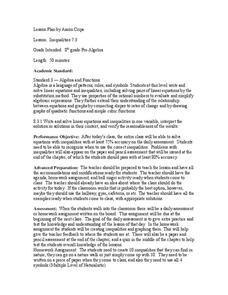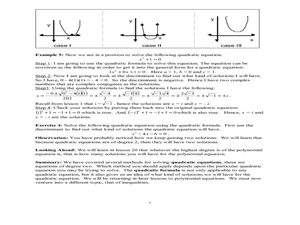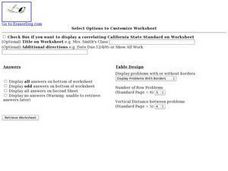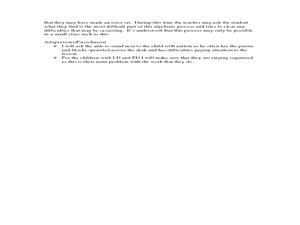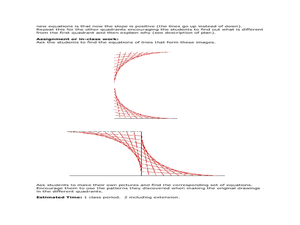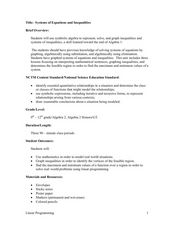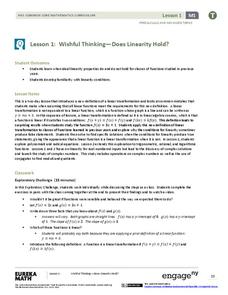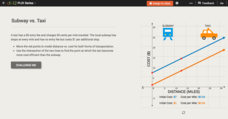Curated OER
Inequalities 7.3
Graph inequalities and discuss the difference in their slopes. Learners observe rate of change as they compare linear, quadratic, and cubic functions.
Curated OER
Quadratic Equations with Negative Discriminate
Solve polynomial equations of degree using different theorems and apply the zero factor theorem for unknown numbers in a quadratic equation. Also use the discriminate to find out the kind of solutions to given quadratic equations shown.
Curated OER
Linear Word Problems
In this linear word problems learning exercise, students solve fifteen different word problems that are related to linear equations. First, they solve various multi-step problems in one variable. Then, students solve and provide...
Curated OER
Graphing Functions
In this graphing functions worksheet, students solve and complete 13 different problems that include identifying and graphing various functions. First, they graph each of the functions shown on the graphs provided. Then, students solve...
Curated OER
Hands-On Algebra
Seventh graders study linear equations. In this algebra activity, 7th graders solve and write two step linear equations in one variable.
Curated OER
Multi-step Equations
For this Algebra I worksheet, 9th graders solve all types of one variable linear equations. The one page worksheet contains a combination of ten multiple choice and free response problems. Answers are provided.
Curated OER
Slope and Intercept
For this slope and intercept worksheet, 10th graders solve 10 different problems that include the graphs of various forms of linear equations. First, they determine the slope of a line given the equation. Then, students determine if the...
Curated OER
Mathematics of Doodles
Students use the slope and y-intercept to graph lines. In this algebra lesson, students graph linear equations and apply it to solving real life problems.
Curated OER
Solving Two Step Equations
In this algebra worksheet, students solve linear equations using the slope and y-intercept. They solve word problems using algebra. There are 9 questions with an answer key.
Curated OER
Equations and Functions
For this algebra worksheet, students solve linear equations and write them in the y-intercept form. They evaluate and solve equations. There are 10 questions with an answer key.
Curated OER
Graphing Systems of Inequalities
Solve equations and graph systems of inequalities. Designed as a lesson to reinforce these concepts, learners revisit shading and boundaries along with solving linear inequalities.
Flipped Math
Unit 2 Review: Create and Solve Equations and Inequalities
Start with the basics. Pupils work through a review of the unit on equations and inequalities. Learners begin with solving equations and inequalities with no context, move on to problems that involve a context, and finish with a...
National Security Agency
Systems of Equations and Inequalities
High school classes can use manipulatives too! Offer hands-on, interactive lessons that venture away from the typical day in your algebra class. Young mathematicians will be involved in collaborative learning, visual...
Mathematics Vision Project
Module 4: Linear and Exponential Functions
Sequences and series are traditionally thought of as topics for the pre-calculus or calculus class, when learners are figuring out how to develop limits. But this unit uses patterns and slopes of linear functions in unique ways...
Charleston School District
Solving Equations with Infinite or No Solutions
Where did all the variables go? Scholars learn how to interpret an equation when they eliminate all variables during the solving process. They interpret the solution as infinite solutions or no solutions.
Washingtonville Central School District
Systems of Equations (Substitutes and Elimination)
With a whopping total of 66 questions, here is a resource that provides a full variety of systems of equations questions using elimination and substitution solution methods.
EngageNY
Wishful Thinking—Does Linearity Hold? (Part 1)
Not all linear functions are linear transformations — show your class the difference. The first instructional activity in a unit on linear transformations and complex numbers that spans 32 segments introduces the concept of linear...
West Contra Costa Unified School District
Solving Systems of Inequalities
Don't throw away those transparency sheets just yet! Young scholars first review inequalities on a number line, then learn about graphing inequalities in the coordinate plane. Finally, they use overhead transparencies to create systems...
CK-12 Foundation
Problem-Solving Models: Subway vs. Taxi
Ride to success in understanding systems of equations. Scholars graph a system of equations on the cost of a subway and a taxi using an interactive. Using this graph allows users to answer some questions about the situation.
Curated OER
Lessen the Loan
Middle-schoolers explore the concept linear equations. They use the internet to navigate through videos and problems. Pupils problem solve to determine rates of change, slope, and x and y-intercepts.
Curated OER
Quadratic-Linear Systems 2: Solve Systems of Equations Involving One Linear Equation and One Quadratic Equation Algebraically
In this solving systems of quadratic and linear equations, students complete three problems. The first problem asks students to solve a system of two equations. One of the equations is a quadratic and the other is linear. The second two...
Curated OER
Linear Functions-Learn Your Lines
Students solve and graph linear equations. In this algebra lesson, students collect and plot data on a coordinate plane. They use the CBL and TI calculator to graph systems of equation.
Curated OER
Sloping and Intersecting a Linear Function
High schoolers examine and discuss typical linear equations, and the difference between a linear and nonlinear equation. They observe examples of linear equations and complete a worksheet.
Curated OER
Solving Systems of Equations by Graphing
In this systems of linear equations worksheet, students graph two equations on each coordinate grid. All systems are linear. One of the systems is parallel. The others have one point of intersection.
